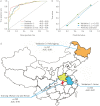A fully automatic deep learning system for COVID-19 diagnostic and prognostic analysis
- PMID: 32444412
- PMCID: PMC7243395
- DOI: 10.1183/13993003.00775-2020
A fully automatic deep learning system for COVID-19 diagnostic and prognostic analysis
Abstract
Coronavirus disease 2019 (COVID-19) has spread globally, and medical resources become insufficient in many regions. Fast diagnosis of COVID-19 and finding high-risk patients with worse prognosis for early prevention and medical resource optimisation is important. Here, we proposed a fully automatic deep learning system for COVID-19 diagnostic and prognostic analysis by routinely used computed tomography.We retrospectively collected 5372 patients with computed tomography images from seven cities or provinces. Firstly, 4106 patients with computed tomography images were used to pre-train the deep learning system, making it learn lung features. Following this, 1266 patients (924 with COVID-19 (471 had follow-up for >5 days) and 342 with other pneumonia) from six cities or provinces were enrolled to train and externally validate the performance of the deep learning system.In the four external validation sets, the deep learning system achieved good performance in identifying COVID-19 from other pneumonia (AUC 0.87 and 0.88, respectively) and viral pneumonia (AUC 0.86). Moreover, the deep learning system succeeded to stratify patients into high- and low-risk groups whose hospital-stay time had significant difference (p=0.013 and p=0.014, respectively). Without human assistance, the deep learning system automatically focused on abnormal areas that showed consistent characteristics with reported radiological findings.Deep learning provides a convenient tool for fast screening of COVID-19 and identifying potential high-risk patients, which may be helpful for medical resource optimisation and early prevention before patients show severe symptoms.
Copyright ©ERS 2020.
Conflict of interest statement
Conflict of interest: S. Wang has nothing to disclose. Conflict of interest: Y. Zha has nothing to disclose. Conflict of interest: W. Li has nothing to disclose. Conflict of interest: Q. Wu has nothing to disclose. Conflict of interest: X. Li has nothing to disclose. Conflict of interest: M. Niu has nothing to disclose. Conflict of interest: M. Wang has nothing to disclose. Conflict of interest: X. Qiu has nothing to disclose. Conflict of interest: H. Li has nothing to disclose. Conflict of interest: H. Yu has nothing to disclose. Conflict of interest: W. Gong has nothing to disclose. Conflict of interest: Y. Bai has nothing to disclose. Conflict of interest: L. Li has nothing to disclose. Conflict of interest: Y. Zhu has nothing to disclose. Conflict of interest: L. Wang has nothing to disclose. Conflict of interest: J. Tian has nothing to disclose.
Figures





References
MeSH terms
LinkOut - more resources
Full Text Sources
Other Literature Sources
Medical
